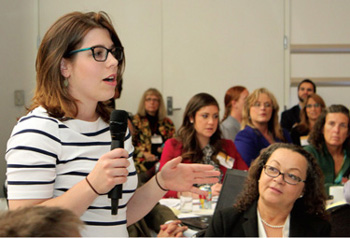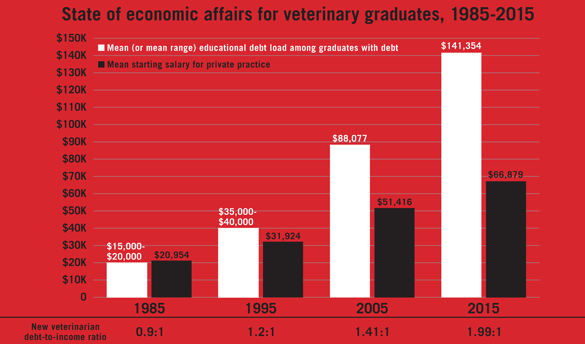Pulling together to lower the debt-to-income ratio
Educational debt is a national concern across professions, as it now exceeds $1.2 trillion—surpassing national credit card debt and auto loan debt combined. However, veterinary medicine has the highest debt-to-income ratio, at least among the various health professions, according to a 2013 article in the New England Journal of Medicine (N Engl J Med 2013;369:1973-1975). The article had veterinary medicine at just above 1.6:1, followed by optometry at 1.3:1 and pharmacy at 1.1:1. It cited slow rises in veterinary income as educational debt “exploded.”
To address this complex issue, the Economics of Veterinary Medical Education Summit was held April 20-22 at Michigan State University College of Veterinary Medicine, co-hosted by the college, the Association of American Veterinary Medical Colleges, and the AVMA.
Many good ideas came from the 180 summit attendees, who represented various facets of the profession. There’s the potential for more widespread advocacy efforts over better terms for student loans (see story). The ideas put forward for revamping veterinary schools may not be new, but perhaps their time has come (see story). And there’s an opportunity to improve financial literacy for applicants and veterinary students (see story).

Dr. Ron DeHaven, AVMA CEO, said the AVMA and AAVMC were positioned to coordinate efforts going forward, in addition to continuing to raise awareness and promote action on strategies through their communication channels.
What the summit’s deliverables hinge on now (see story), at least according to Dr. Andrew Maccabe, executive director of the AAVMC, is accountability, transparency, and most important, action.
In fact, one of the commitments made by representatives of the various associations and organizations represented at the summit was “To include student debt as a regular follow-up agenda item at annual events such as the AVMA Economic Summit, AVMA Convention, and AAVMC Conference; the purpose of this would be to monitor progress on efforts to reduce the debt-to-income ratio and to hold each other accountable.”
Dr. Trevor Ames, dean of the University of Minnesota College of Veterinary Medicine, said, “Probably the greatest value of these meetings is they promote greater understanding of the challenges each group faces, so we get beyond thinking that it’s someone else’s problem to solve. It’s all of our problem to solve.”
Four goals for reducing the debt-to-income ratio
The collective goal over the three-day summit was to agree on specific strategies to address the many facets of this complex challenge, with the idea of focusing on the debt-to-income ratio as a way to measure progress. Among the 2015 graduates of the accredited U.S. veterinary colleges, the DIR was 2:1, meaning that, on average, educational debt was approximately twice the starting income.

Michael Dicks, PhD, the AVMA’s chief economist, said he is going to be the “scorekeeper” of the DIR going forward. And he outlined four major goals that he calculates would reduce that number.
The first would be to eliminate the difference between debt students incur and the actual cost to attend, through better management of expenses, potentially resulting in $9 million in savings. The second goal would be to eliminate interest on loans during school through lobbying efforts, which would save $22 million, Dr. Dicks estimates. Third would be to grow starting salaries by 10 percent by improving practice profitability, allowing new graduates to earn more. This could mean another $22 million in reducing the DIR. And last would be to reduce educational costs by 10 percent through various approaches, which would mean a savings of $43 million. (Dr. Dicks details these goals in the 2016 AVMA & AAVMC Report on the Market for Veterinary Education; see story).
Dr. Dicks said if all four goals were phased in between now and 2020, the DIR could drop to 1.62:1 by 2025. But, taking into account two potential recessions in coming years, a continuing increase in seats, and three more veterinary colleges opening, it's more likely the figure would be reduced to 1.72:1 by 2023. “No matter how hard we try, these four changes won’t have the impact desired,” which is a DIR of 1.4:1 by 2025, he said. For that to happen, structural changes would be needed by 2020.

Dr. Ames called the DIR a “useful tool to start discussion and start changing behavior,” particularly a college’s conversations with central administration during budget presentations and with the state legislature. For the past three years, he has asked Minnesota lawmakers to freeze tuition and was able to do this for two years and part of a third.
Dr. Tony Bartels of the Veterinary Information Network asked during the summit whether cutting tuition was feasible. Dr. Andrew Lovelady, associate professor of large animal ambulatory medicine at Tuskegee University School of Veterinary Medicine, explained that veterinary colleges can’t decide to cut tuition overnight.
“All those things come from the top. And not all tuition dollars are made available for use, so an increase or decrease in tuition doesn’t exactly change money available to an institution,” he said.
Deja vu all over again
Reducing education costs. Managing debt load better. Helping new graduates become economic assets to the practice to offset costs and increase salary. Expanding professional opportunities.
These were some of the primary themes that came from the summit. They also happen to be the same solutions from the Managing Your Economic Future in Veterinary Medicine symposium, which took place April 13-14, 1996. Both meetings brought together stakeholders in the profession to address the economic future of veterinary students and recent graduates as well as that of the entire profession. At the meeting 20 years ago, however, the debt-to-income ratio for recent veterinary graduates stood at only 1.2:1.
Calling the predicament a “horrendous burden” affecting the lives of students and new graduates, then AVMA President Sherbyn W. Ostrich read what he called “a letter of despair” from a student with a debt load of greater than $100,000. “‘I do not believe older practitioners can fathom the debt younger veterinarians have,’” he read (J Am Vet Med Assoc 1996;209:199-246). Today, roughly 16 percent of new veterinarians report debt from veterinary college in excess of $222,000, according to the 2016 AVMA & AAVMC Report on the Market for Veterinary Education.

Years from now, veterinarians looking back at the debt summit held at Michigan State will know whether the conceptual solutions were put into action and whether they were enough to make a difference.